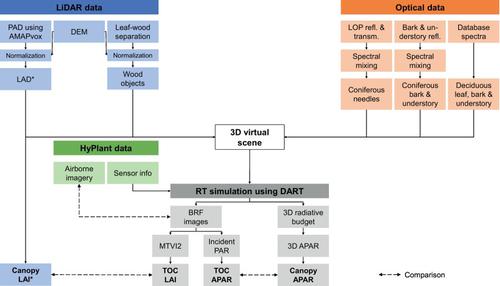当前位置:
X-MOL 学术
›
Remote Sens. Environ.
›
论文详情
Our official English website, www.x-mol.net, welcomes your feedback! (Note: you will need to create a separate account there.)
Diversity of 3D APAR and LAI dynamics in broadleaf and coniferous forests: Implications for the interpretation of remote sensing-based products
Remote Sensing of Environment ( IF 13.5 ) Pub Date : 2024-03-26 , DOI: 10.1016/j.rse.2024.114116 Jasmin Kesselring , Felix Morsdorf , Daniel Kükenbrink , Jean-Philippe Gastellu-Etchegorry , Alexander Damm
Remote Sensing of Environment ( IF 13.5 ) Pub Date : 2024-03-26 , DOI: 10.1016/j.rse.2024.114116 Jasmin Kesselring , Felix Morsdorf , Daniel Kükenbrink , Jean-Philippe Gastellu-Etchegorry , Alexander Damm

|
Forests substantially mediate the water and carbon dioxide exchanges between terrestrial ecosystems and the atmosphere. The rate of this exchange, including evapotranspiration (ET) and gross primary production (GPP), depends mainly on the underlying vegetation type, health state, and the composition of abiotic environmental drivers. However, the complex 3D structure of forest canopies and the inherent top-view perspective of optical and thermal remote sensing complicate remote sensing-based retrievals of biotic and abiotic factors that eventually determine ET and GPP. This study investigates the sensitivity of remote sensing approaches to 3D variation of abiotic and biotic environmental drivers. We use 3D virtual scenes of two structurally different Swiss forests and the radiative transfer model DART to simulate the 3D distribution of solar irradiance and reflected radiance in the forest canopy. These simulations, in combination with LiDAR data, are used to derive the absorbed photosynthetic active radiation (APAR) and the leaf area index (LAI) in 3D space. The 3D variation of both parameters was quantified and analyzed. We then simulated images of the top-of-canopy bi-directional reflectance factor (BRF) and compared them with the hemispheric-conical reflectance factor (HCRF) data derived from HyPlant airborne imaging spectrometer measurements. The simulated BRF data was used to derive APAR and LAI, and the results were compared to their respective 3D representations. We unravel considerable spatial differences between both representations. We discuss possible reasons for the disagreement, including a potential insensitivity of the inherent top-of-canopy view for the real 3D product dynamics and limitations of the processing of remote sensing data, especially the approximation of effective surface irradiance. Our results can help understanding sources of uncertainties in remote sensing based gas exchange products and defining mitigation strategies.
中文翻译:

阔叶林和针叶林 3D APAR 和 LAI 动态的多样性:对遥感产品解释的影响
森林在很大程度上调节陆地生态系统和大气之间的水和二氧化碳交换。这种交换率,包括蒸散量 (ET) 和初级生产总值 (GPP),主要取决于基础植被类型、健康状况和非生物环境驱动因素的构成。然而,森林冠层复杂的 3D 结构以及光学和热遥感固有的顶视图使最终决定 ET 和 GPP 的生物和非生物因素的基于遥感的检索变得复杂。本研究调查了遥感方法对非生物和生物环境驱动因素 3D 变化的敏感性。我们使用两个结构不同的瑞士森林的 3D 虚拟场景和辐射传输模型 DART 来模拟森林冠层中太阳辐照度和反射辐射的 3D 分布。这些模拟与 LiDAR 数据相结合,用于推导 3D 空间中的吸收光合有效辐射 (APAR) 和叶面积指数 (LAI)。对两个参数的 3D 变化进行了量化和分析。然后,我们模拟了冠层顶部双向反射系数 (BRF) 的图像,并将其与从 HyPlant 机载成像光谱仪测量得出的半球圆锥反射系数 (HCRF) 数据进行比较。模拟的 BRF 数据用于导出 APAR 和 LAI,并将结果与它们各自的 3D 表示进行比较。我们揭示了两种表示之间相当大的空间差异。我们讨论了分歧的可能原因,包括固有的冠层顶部视图对真实 3D 产品动力学的潜在不敏感性以及遥感数据处理的局限性,尤其是有效表面辐照度的近似。我们的结果可以帮助了解基于遥感的气体交换产品的不确定性来源并确定缓解策略。
更新日期:2024-03-26
中文翻译:

阔叶林和针叶林 3D APAR 和 LAI 动态的多样性:对遥感产品解释的影响
森林在很大程度上调节陆地生态系统和大气之间的水和二氧化碳交换。这种交换率,包括蒸散量 (ET) 和初级生产总值 (GPP),主要取决于基础植被类型、健康状况和非生物环境驱动因素的构成。然而,森林冠层复杂的 3D 结构以及光学和热遥感固有的顶视图使最终决定 ET 和 GPP 的生物和非生物因素的基于遥感的检索变得复杂。本研究调查了遥感方法对非生物和生物环境驱动因素 3D 变化的敏感性。我们使用两个结构不同的瑞士森林的 3D 虚拟场景和辐射传输模型 DART 来模拟森林冠层中太阳辐照度和反射辐射的 3D 分布。这些模拟与 LiDAR 数据相结合,用于推导 3D 空间中的吸收光合有效辐射 (APAR) 和叶面积指数 (LAI)。对两个参数的 3D 变化进行了量化和分析。然后,我们模拟了冠层顶部双向反射系数 (BRF) 的图像,并将其与从 HyPlant 机载成像光谱仪测量得出的半球圆锥反射系数 (HCRF) 数据进行比较。模拟的 BRF 数据用于导出 APAR 和 LAI,并将结果与它们各自的 3D 表示进行比较。我们揭示了两种表示之间相当大的空间差异。我们讨论了分歧的可能原因,包括固有的冠层顶部视图对真实 3D 产品动力学的潜在不敏感性以及遥感数据处理的局限性,尤其是有效表面辐照度的近似。我们的结果可以帮助了解基于遥感的气体交换产品的不确定性来源并确定缓解策略。



























 京公网安备 11010802027423号
京公网安备 11010802027423号